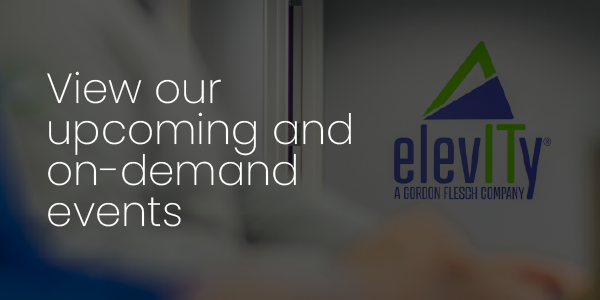Sometimes within an organization there’s a disconnect between the Information Technology (IT) team and the rest of the business. With the adoption of an IT-as-a-Service (ITaaS) model, it’s possible to bridge these gaps and enable better communication between departments, keeping everyone on the same page.
At some companies, ITaaS is a framework for how an IT service provider delivers an information technology service to a client business. At Elevity, we go beyond the standard ITaaS model — acting not just as a provider, but as a strategic partner who helps drive your business forward.
Infographic: Traditional IT vs Technology Management
Characteristics & Benefits of an IT-as-a-Service Model
In recent years, the value of ITaaS has truly been recognized by the business world. Organizations today need a scalable and dynamic IT model, not the static, old-fashioned IT model of yesteryear.
By using ITaaS, companies enjoy all the technology they need to run a business, but with the flexibility and freedom to strategically deploy technology and move the company forward as needed. ITaaS’s characteristic flexibility is what organizations need as they grow and change. For some companies these changes have included remote work or hybrid working protocols; for others new technology tools have been needed.
Through our work with clients, we’ve found that ITaaS offers the following five primary benefits:
- Scalability: ITaaS enables companies to consume and pay for only the IT needed and to adjust if needs fluctuate. For example, service providers can deploy new cloud capacity when capacity spikes or provide additional storage during large deployments.
- Knowledge: By employing a model based on IT consumption, managers and executives can gain a better understanding of the circumstances in which IT services are used. This also provides them with enhanced knowledge about asset performance and finances related to the utilization of their technology resources.
- New Capabilities: Technology Management services leverage specialized experience and proficiency to assist businesses with projects that require a great deal of time and effort, such as updating software and applying security patches.
- Freedom: IT teams often spend much of their days on mundane tasks or putting out fires. With an ITaaS model in place, IT work can be shifted based on capacities and conducted where it’s needed most, which frees up resources to continue their work on more value-added initiatives.
- Save Money: Using ITaaS, companies pay only for the actual use and consumption of the services, eliminating the waste associated with subscription models. Long-term savings include optimization of resources, equipment maintenance and protection against cybersecurity threats or other harmful incidents.
Request a Consultation to Learn More
Next-Level ITaaS: Technology Management
ITaaS gives organizations the ability to rapidly scale IT capacity, operations and associated costs up or down as needed. This is crucial for companies looking to stay resilient and nimble in today’s business environment. However, we believe that ITaaS is not just about outsourcing your infrastructure and support service.
At Elevity, we believe growing companies need Technology Management — the strategic alignment of technology and an organization’s business goals. This is an important distinction because many businesses don’t think of IT as a strategic asset, but as a sunk cost.
But that way of thinking is outdated. Whether your business needs fully managed service or co-managed service, going the more comprehensive Technology Management route sets your business up for success. Elevity looks at these types of services in the context of our 4S approach: Strategy, Security, Solutions and Support.
We partner with clients to develop a Technology Management Strategy and roadmap that fit your business needs and your budget. We offer Security in everything we do to protect your valuable assets from cybercriminals. The Solutions we offer are backed by expertise and industry leaders, including Microsoft. And once the Technology Management plan is implemented, we Support your team to ensure continued success.
Wondering what a roadmap to implement Managed IT at your organization could look like? Download our Roadmap for Implementing Managed IT infographic and follow the seven steps to ensure a smooth transition.










%20cropped.webp?width=200&height=200&name=Alec_Brown%20(Pro)%20cropped.webp)





